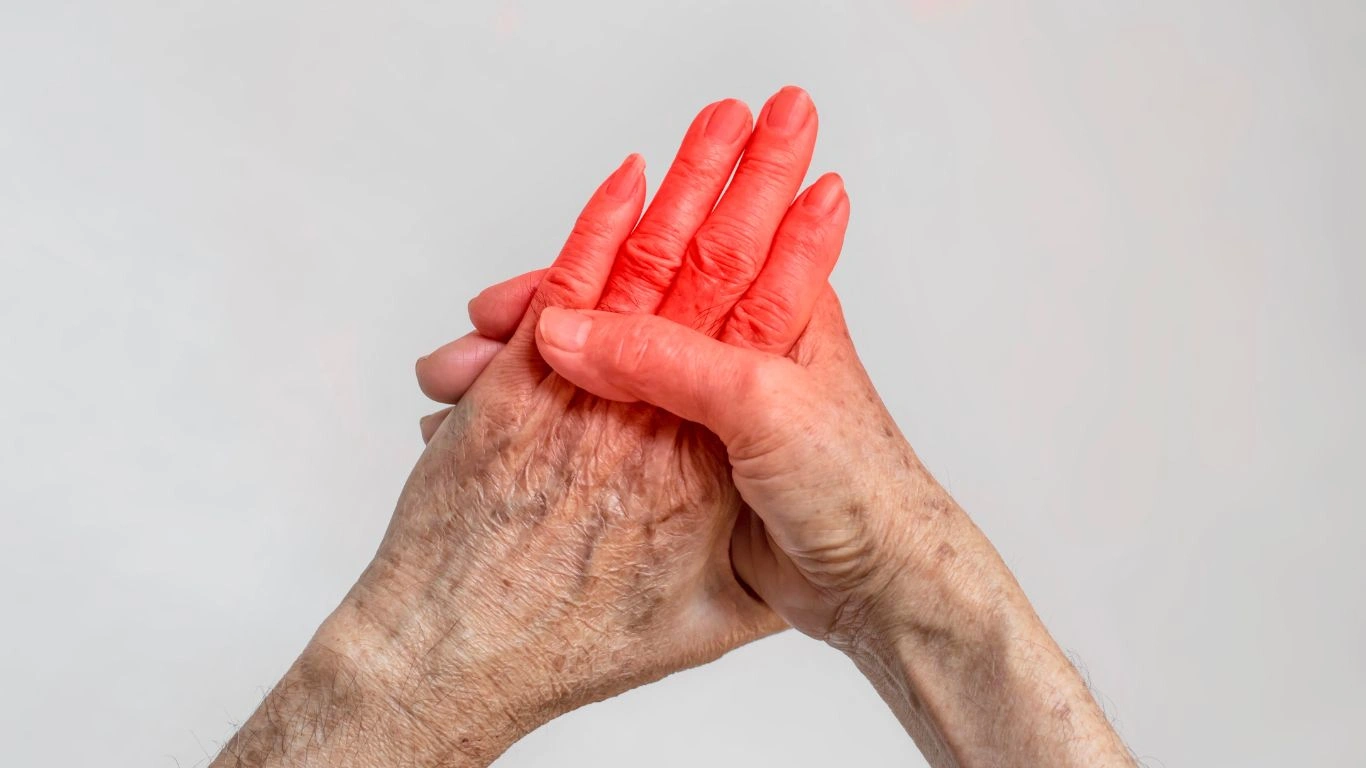Can Rheumatoid Arthritis Cause Numbness in Hands? A Guide to Relief & Care
Rheumatoid arthritis (RA) is a chronic autoimmune condition that affects millions of people worldwide, and as someone who works closely with individuals dealing with RA, I’ve seen firsthand how it can truly impact daily life. One of the more concerning and sometimes overlooked symptoms of RA is the sensation of numbness in the hands. If you’re wondering, “Can rheumatoid arthritis cause numbness in hands?”, the answer is yes – it absolutely can. Numbness in the hands can be one of the many frustrating symptoms of RA, and while it’s often associated with joint inflammation, it can also be linked to other aspects of the disease, including nerve involvement. Let’s dive into how rheumatoid arthritis can lead to this issue and what you need to know.
Understanding the Connection Between Rheumatoid Arthritis and Numbness

Rheumatoid arthritis primarily targets the joints, causing inflammation, pain, and swelling. However, RA isn’t just limited to joints – it can also affect the surrounding tissues and even the nerves. The inflammation in the joints, particularly in the wrists, hands, and fingers, can lead to pressure on the nerves, resulting in a sensation of numbness. But how does this happen? Let’s break it down a little further.
Joint Inflammation and Its Effect on Nerve Function
When RA causes inflammation in the joints, it doesn’t just stay in the joint itself. Inflammation can spread to the surrounding tissues, including the synovium (the lining of the joint). Over time, chronic inflammation can lead to thickening of the synovium, which can compress nearby nerves. This pressure on the nerves often results in symptoms like tingling, numbness, or even weakness in the hands and fingers.
One of the most common areas for this nerve compression to occur is in the wrists. This area is particularly vulnerable due to the presence of the carpal tunnel, a narrow passageway in the wrist through which nerves and tendons pass. When the carpal tunnel becomes constricted due to swollen tissues, it can lead to what’s known as carpal tunnel syndrome – a condition that causes numbness and tingling in the hands, especially in the thumb, index, and middle fingers.
The Role of Inflammation in Nerve Damage
RA-related inflammation can also affect the nerves directly. In some cases, persistent inflammation can lead to nerve damage, which may contribute to numbness or loss of sensation in the hands. This kind of nerve damage is often referred to as peripheral neuropathy, a condition where the peripheral nerves (those outside of the brain and spinal cord) are damaged, leading to symptoms like numbness, tingling, and weakness in the hands or feet.
If you’re noticing that numbness or tingling in your hands gets worse as the day goes on or after you’ve been using your hands for extended periods, it could be a sign of nerve compression or inflammation. It’s not just the joint pain that can disrupt daily life – these sensory changes can make everyday tasks like typing, holding objects, or even driving much more difficult.
How Do I Know if Numbness is Linked to Rheumatoid Arthritis?

If you’re living with rheumatoid arthritis and are experiencing numbness in your hands, it’s important to understand the potential connection. While joint pain and swelling are the most common symptoms, the additional presence of numbness can signal a more complex interaction of inflammation and nerve compression. So, how can you tell if it’s related to RA or another condition? Here are some signs to look out for:
- Worsening symptoms with activity: If the numbness increases after prolonged use of your hands, like typing, writing, or gripping objects, it could be due to nerve compression from inflammation.
- Joint swelling and pain: If you also experience swelling or pain in the joints of your wrists, fingers, or hands along with the numbness, it’s likely related to your RA.
- Consistency and timing: Numbness that occurs regularly or at certain times of day, such as in the morning after waking up or after using your hands a lot, can also point to RA-related nerve compression.
- Symptoms in both hands: Rheumatoid arthritis often affects both sides of the body symmetrically, so numbness or tingling in both hands could be a sign of RA involvement.
If you’re noticing these signs, it’s crucial to discuss them with your healthcare provider. The symptoms could be related to RA, but they might also be caused by other conditions, such as carpal tunnel syndrome or peripheral neuropathy, so it’s important to get an accurate diagnosis and appropriate treatment plan. As someone who regularly assesses RA patients, I know that early detection of these symptoms can make a big difference in managing them effectively.
Why Early Treatment Is Key

When numbness in the hands is related to RA, early intervention is crucial. If left untreated, persistent inflammation and nerve compression can lead to long-term damage, including permanent numbness or weakness in the hands. This is why it’s so important to take action as soon as you notice any changes in sensation in your hands. Managing inflammation through medication, physical therapy, and lifestyle changes can help reduce the pressure on your nerves and prevent further damage.
As a Rheumatology Nurse Practitioner, I’ve seen patients benefit greatly from proactive treatment plans that target both the inflammation and the symptoms like numbness. With the right care, you can reduce pain, improve function, and maintain a good quality of life. Don’t wait to bring up new symptoms like numbness to your healthcare provider – early treatment really can make all the difference!
How Rheumatoid Arthritis Affects Nerves: A Deeper Look

As we dive deeper into how rheumatoid arthritis (RA) can lead to numbness in the hands, it’s essential to understand that the effects of RA go beyond just joint pain and swelling. While it’s commonly recognized that RA attacks the joints, we often overlook how it can have a significant impact on the nervous system. This section will further explore how RA affects the nerves and why numbness in the hands may be a warning sign that should never be ignored.
Systemic Inflammation and Its Reach
Rheumatoid arthritis is classified as an autoimmune disease, meaning the body’s immune system mistakenly attacks its own tissues. This leads to widespread inflammation not only in the joints but throughout the body. Inflammation isn’t just confined to the synovium (the lining of the joints); it can also affect blood vessels and the nervous system. Chronic systemic inflammation from RA can actually alter the way nerves function, leading to sensations of numbness, tingling, or even sharp pain.
Over time, prolonged inflammation can damage the small blood vessels that supply the nerves. When blood flow to the nerves is compromised, the nerves themselves can become damaged, and you may begin to experience symptoms like numbness in the hands. This is why it’s so important for RA patients to manage inflammation effectively – not just for joint health but for overall nerve health as well.
The Role of Peripheral Neuropathy in RA
Peripheral neuropathy is a term used to describe nerve damage outside the brain and spinal cord. It’s a condition that can develop when nerves become damaged from inflammation, and it’s one of the more serious consequences of untreated RA. People with rheumatoid arthritis are more likely to develop peripheral neuropathy than those without it. The symptoms can vary, but they often include tingling, burning sensations, weakness, and, as we’ve mentioned, numbness in the hands.
The connection between RA and peripheral neuropathy is often due to both the direct and indirect effects of chronic inflammation. First, inflammation can cause swelling in the joints, which puts pressure on the nerves. Second, the systemic inflammation can affect the blood vessels that supply oxygen and nutrients to the nerves. As a result, nerve function is compromised, leading to uncomfortable or even debilitating symptoms. It’s not uncommon for patients to report numbness in both hands or in one hand at a time, sometimes accompanied by a “pins and needles” feeling.
Recognizing the Warning Signs: What to Look For

If you’re living with rheumatoid arthritis, it’s crucial to be aware of the warning signs that could indicate nerve involvement. Numbness in the hands should never be brushed aside – it’s important to monitor your symptoms and bring them up with your healthcare provider. Here’s a deeper look into what symptoms to watch out for and why early intervention is key.
Common Symptoms of RA-Related Numbness
Rheumatoid arthritis can cause a variety of symptoms that go beyond the typical joint pain. When it comes to numbness, you might notice some of the following signs:
- Morning numbness: Many RA patients report waking up in the morning with numb or tingling hands, which can last for a few minutes or longer. This could be a sign that inflammation is compressing the nerves overnight, especially if you tend to sleep in positions that put pressure on the wrists or hands.
- Numbness after activity: If you experience numbness after using your hands for tasks like typing, cooking, or gripping objects, it could indicate that inflammation is exacerbating nerve compression. RA can make it harder for your hands to recover from these activities, leading to lingering sensations.
- Sensation changes: It’s not just numbness – some people also experience sensations like “pins and needles” or a “burning” feeling in their hands, especially after prolonged activity. These sensory changes are often linked to nerve irritation or compression due to RA-related inflammation.
- Symmetry: One hallmark of RA is that it often affects both sides of the body. If you’re experiencing numbness in both hands, this could be an indication that RA is causing nerve compression in both wrists or fingers, which is relatively common.
Recognizing these symptoms early on can be the difference between managing the issue with targeted treatment and letting it progress to more serious nerve damage. It’s essential to keep track of when these symptoms occur, how severe they are, and whether they’re affecting your ability to perform daily activities.
Diagnosis and Treatment Options

If you’re noticing numbness or tingling in your hands and suspect it’s related to rheumatoid arthritis, your next step should be a visit to your healthcare provider. It’s important not to self-diagnose or assume that it’s just a typical RA flare-up. The exact cause of the numbness needs to be pinpointed, as there are various conditions that can contribute to these symptoms.
How Healthcare Providers Diagnose RA-Related Numbness
Diagnosing numbness as it relates to rheumatoid arthritis typically involves a combination of clinical evaluation, patient history, and diagnostic tests. Your doctor may perform a physical exam, checking for signs of joint inflammation, deformities, and changes in sensation. They might also ask you about the pattern of your symptoms, such as when the numbness occurs and how long it lasts.
In addition to the physical exam, your provider may order imaging tests like X-rays or MRI scans to assess the extent of joint damage. If nerve compression or peripheral neuropathy is suspected, additional tests, such as nerve conduction studies or electromyography (EMG), might be used to evaluate how well your nerves are functioning.
Treatment Options for Numbness and Nerve Involvement
Once a diagnosis is made, your healthcare provider will develop a treatment plan tailored to your needs. Managing rheumatoid arthritis-related numbness often requires a multifaceted approach:
- Medications: Nonsteroidal anti-inflammatory drugs (NSAIDs), disease-modifying antirheumatic drugs (DMARDs), or biologic medications can help reduce inflammation and prevent further nerve compression.
- Physical therapy: A physical therapist can help you strengthen the muscles around your joints, improving mobility and reducing the pressure on the nerves. This can be especially helpful for managing symptoms in the wrists and hands.
- Splints and braces: Wearing splints or braces on the wrists and hands may help relieve pressure on the nerves during sleep or while performing certain activities.
- Surgery: In some cases, when nerve compression is severe and doesn’t respond to other treatments, surgical intervention may be considered to relieve pressure on the affected nerves.
In my experience as a Rheumatology Nurse Practitioner, I’ve seen patients significantly improve their symptoms by following a well-rounded treatment plan. Early intervention and consistent management can prevent nerve damage and help maintain hand function, allowing individuals to lead a more comfortable life despite RA.
Living with Rheumatoid Arthritis and Numbness: Tips for Managing Symptoms

Dealing with rheumatoid arthritis (RA) is tough enough without the added frustration of numbness in the hands. The good news is that with the right strategies, it’s possible to manage both RA and the symptoms of numbness that can make daily life challenging. Over the years of working with patients, I’ve seen how important it is to not just focus on joint pain but also address the associated symptoms like numbness. In this section, I’ll share some practical tips and insights based on both personal experience and clinical expertise to help manage numbness caused by RA.
1. Stay On Top of Your RA Treatment Plan
The foundation of managing RA-related numbness starts with effectively managing your RA itself. This includes sticking to your prescribed treatment plan, which may include medications, physical therapy, and lifestyle changes. By controlling inflammation and reducing joint damage, you can also minimize the pressure on your nerves.
Medications: RA treatment often includes disease-modifying antirheumatic drugs (DMARDs) or biologics that target the underlying causes of inflammation. These treatments not only help prevent joint damage but also reduce inflammation that could be contributing to nerve compression and numbness in the hands. If you’re not seeing the results you need, don’t hesitate to talk to your doctor about adjusting your treatment plan.
Physical therapy: I can’t stress enough how helpful physical therapy can be for improving hand function and reducing numbness. A skilled physical therapist can teach you exercises to strengthen the muscles around your joints and improve your range of motion. In my experience, regular hand and wrist exercises can greatly reduce the chances of nerve compression caused by RA inflammation. In some cases, the therapist might also recommend custom splints to support your wrists during the night to prevent further strain.
2. Implement Lifestyle Changes to Support Joint and Nerve Health
Along with medications and physical therapy, adopting healthy lifestyle habits can make a big difference in how you manage both RA and the numbness that comes with it. Here are some suggestions to consider:
- Stay active: Regular low-impact exercise, such as swimming or walking, can help keep your joints moving and reduce stiffness. Plus, keeping your body active helps with blood circulation, which is essential for healthy nerve function.
- Maintain a healthy weight: Excess weight puts added pressure on your joints, particularly in weight-bearing areas like the knees and hips. By managing your weight, you help relieve this pressure, which can reduce the strain on your hands and wrists.
- Prioritize rest: While staying active is important, it’s equally crucial to give your body time to rest and recover. Taking short breaks throughout the day and getting enough sleep will help prevent flare-ups and reduce inflammation.
- Reduce stress: Stress can trigger or worsen RA symptoms, so finding ways to manage stress is key. Practices like yoga, meditation, or simply taking time each day to relax can help you maintain balance and keep inflammation under control.
3. Use Tools to Make Daily Tasks Easier
In my practice, I often encourage patients to make their home and work environments more accommodating to their needs. Using the right tools and aids can help reduce the strain on your hands and wrists, making it easier to manage everyday tasks. Here are a few suggestions:
- Ergonomic tools: Investing in ergonomic keyboards, chairs, or hand tools can help alleviate pressure on your hands while you work or perform daily activities. Look for tools with padded grips or larger handles to reduce the strain on your fingers.
- Assistive devices: There are many assistive devices available that can help with tasks like opening jars, turning keys, or brushing your teeth. These tools are designed to reduce the amount of grip strength needed and make daily tasks more manageable.
- Heat and cold therapy: Heat pads and cold packs can help relieve discomfort in your hands and wrists. Heat can increase blood flow to the area, while cold can reduce swelling and numbness. Both therapies are valuable tools for managing RA symptoms and preventing further nerve damage.
Understanding the Bigger Picture: RA and Overall Health

When it comes to rheumatoid arthritis, it’s easy to get caught up in focusing solely on joint pain and numbness in the hands, but RA is a systemic disease, meaning it can impact other areas of your health as well. It’s essential to take a holistic approach to managing your health, looking beyond just the joints to ensure your entire body is functioning optimally.
Mind-Body Connection in RA
RA is known to affect not just the body but also mental health. Dealing with chronic pain, joint damage, and symptoms like numbness can take a toll on your mental well-being. Many RA patients experience anxiety, depression, or stress, which can, in turn, exacerbate physical symptoms. That’s why it’s so important to take care of both your physical and mental health. Therapy, counseling, and even support groups can help you manage the emotional burden of living with RA. I’ve worked with many patients who found tremendous relief from RA symptoms just by addressing their emotional and mental health needs.
Routine Checkups and Monitoring
Regular visits to your healthcare provider are essential for managing rheumatoid arthritis, especially when it comes to symptoms like numbness. By staying on top of your condition, you can identify any changes in your symptoms early and adjust your treatment plan as needed. Monitoring blood tests, joint health, and nerve function can help you stay ahead of any potential complications and prevent further damage.
As someone who’s spent years working closely with RA patients, I can’t emphasize enough how important it is to be proactive in managing your condition. Whether it’s through medication, physical therapy, or simple lifestyle adjustments, there are many ways to keep RA and numbness under control. The earlier you address the issue, the better your chances are of maintaining a high quality of life.
References
Disclaimer: The information provided in this article is for educational purposes only and should not be considered medical advice. Please consult with a healthcare professional for a personalized diagnosis and treatment plan based on your specific health needs.

Tarra Nugroho is a dedicated Nurse Practitioner with a strong foundation in family and preventive care. She brings both compassion and clinical expertise to her practice, focusing on patient-centered care and health education. As a contributor to Healthusias.com, Tarra translates medical knowledge into clear, empowering articles on topics like women’s health, chronic disease management, and lifestyle medicine. Her mission is simple: help people feel seen, heard, and informed—both in the clinic and through the content she creates. When she’s not caring for patients, Tarra enjoys weekend hikes, plant-based cooking, and curling up with a good health podcast.






